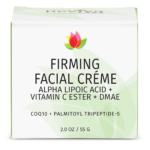DMAE
Dimethylaminoethanol, often abbreviated as DMAE, is a naturally occurring compound produced by the human brain and also found in certain foods such as sardines and anchovies. It’s used widely in the skincare and healthcare industry due to its potential benefits for brain health and skin appearance. In skincare products, DMAE is known to improve skin firmness and reduce the appearance of wrinkles. As a supplement, it’s believed to enhance memory and cognitive function, though research is still ongoing. Its potential for boosting neural health makes it a topic of interest in nootropic circles.
Dimethylaminoethanol (DMAE) is often called “facelift in a jar” by skin care specialists, because it helps firm and tighten the skin. With regular use DMAE will give skin a more defined, youthful appearance. DMAE has been reported by Dermatological studies to help firm and tone throat and facial skin.
References
- DMAE – Is it Really a “Facelift-in-a-Jar”? https://www.amaskincare.com/dmae-benefits-skin-tightening-loose-skin/
- Grossman R. The role of dimethylaminoethanol in cosmetic dermatology. Am J Clin Dermatol. 2005;6(1):39‐47. doi:10.2165/00128071-200506010-00005
- Uhoda I, Faska N, Robert C, Cauwenbergh G, Piérard GE. Split face study on the cutaneous tensile effect of 2-dimethylaminoethanol (deanol) gel. Skin Res Technol. 2002;8(3):164‐167. doi:10.1034/j.1600-0846.2002.10295.x
- Morissette G, Germain L, Marceau F. The antiwrinkle effect of topical concentrated 2-dimethylaminoethanol involves a vacuolar cytopathology. Br J Dermatol. 2007;156(3):433‐439. doi:10.1111/j.1365-2133.2007.07681.x
- Liu S, Chen Z, Cai X, et al. Effects of dimethylaminoethanol and compound amino acid on D-galactose induced skin aging model of rat. ScientificWorldJournal. 2014;2014:507351. doi:10.1155/2014/507351
- Tadini KA, Campos PM. In vivo skin effects of a dimethylaminoethanol (DMAE) based formulation. Pharmazie. 2009;64(12):818‐822.
- https://www.ncbi.nlm.nih.gov/pmc/articles/PMC4123624/
Dimethylethanolamine (DMAE or DMEA) is an organic compound with the formula (CH3)2NCH2CH2OH. It is bifunctional, containing both a tertiary amine and primary alcohol functional groups. It is a colorless viscous liquid. It is used in skin care products for improving skin tone and also taken orally as a nootropic. It is prepared by the ethoxylation of dimethylamine.

| |

| |
| Names | |
|---|---|
| Preferred IUPAC name
2-(Dimethylamino)ethan-1-ol | |
| Other names
deanol, dimethylaminoethanol, dimethyl ethanolamine
| |
| Identifiers | |
3D model (JSmol)
|
|
| Abbreviations | DMAE, DMEA |
| 1209235 | |
| ChEBI | |
| ChEMBL | |
| ChemSpider | |
| ECHA InfoCard | 100.003.221 |
| EC Number |
|
| KEGG | |
| MeSH | Deanol |
PubChem CID
|
|
| RTECS number |
|
| UNII | |
| UN number | 2051 |
CompTox Dashboard (EPA)
|
|
| |
| |
| Properties | |
| C4H11NO | |
| Molar mass | 89.138 g·mol−1 |
| Appearance | Colourless liquid |
| Odor | Fishy, ammoniacal |
| Density | 890 mg mL−1 |
| Melting point | −59.00 °C; −74.20 °F; 214.15 K |
| Boiling point | 134.1 °C; 273.3 °F; 407.2 K |
| log P | −0.25 |
| Vapor pressure | 816 Pa (at 20 °C) |
| Acidity (pKa) | 9.23 (at 20 °C) |
| Basicity (pKb) | 4.77 (at 20 °C) |
Refractive index (nD)
|
1.4294 |
| Pharmacology | |
| N06BX04 (WHO) | |
| Hazards | |
| GHS labelling: | |
  
| |
| Danger | |
| H226, H302, H312, H314, H332 | |
| P280, P305+P351+P338, P310 | |
| Flash point | 39 °C (102 °F; 312 K) |
| Explosive limits | 1.4–12.2% |
| Lethal dose or concentration (LD, LC): | |
LD50 (median dose)
|
|
| Related compounds | |
Related alkanols
|
|
Related compounds
|
Diethylhydroxylamine |
Except where otherwise noted, data are given for materials in their standard state (at 25 °C [77 °F], 100 kPa).
| |









